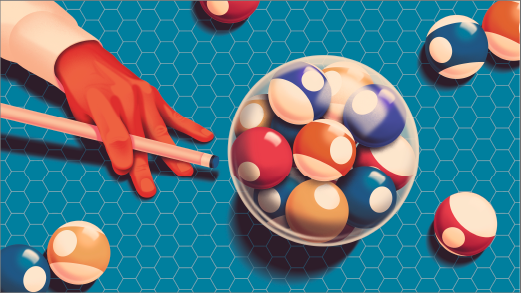Long Ju, a physicist at MIT who specializes in 2D materials, was also in pursuit of the effect. Ju stuck five layers of carefully aligned graphene between boron nitride, cooled it down, and measured the resistance.
Again, the characteristic fractional plateaus appeared without any magnetic field. “It was a total surprise,” Ju said.
While some studies indicated that TMDs would exhibit the effect (at the right twist angle, the materials were expected to produce a powerful effective internal magnetic field), no theorist had predicted that the effect would show up in a material like Ju’s at MIT. The discovery has led to a good deal of head-scratching.
Cano, at Stony Brook, spent her graduate school years delightedly puzzling over the fractional quantum Hall effect, which has since been mostly resolved. “I thought that was in the rearview mirror,” she said. “It was very exciting to me when these kinds of developments in twisted TMDs and graphene came up.” Cano and other theorists are thinking about how to model the materials, but it’s not easy. “They buckle, they ripple, they strain, they distort, and so it’s actually very difficult to make a quantitatively correct model,” she said.
The difficulty, when it comes to understanding the fractional quantum anomalous Hall effect, is twofold. Theorists must first grapple with what is actually happening in the experimental samples. Then they have to consider: What can electrons do, in principle?
The exact role of the moiré pattern remains poorly understood. Some theorists initially wondered whether the moiré is needed at all. Perhaps the magic was all in the graphene. Unpublished results from Ju’s group have since shown that without the mismatched hexagonal boron nitride and graphene lattices, there are no fractional charges. “It’s clear that the moiré is important,” Bernevig said.
One possibility is that the layered graphene could be host to a so-called anomalous Hall crystal. Unlike a physical crystal made of a lattice of atoms, such as a diamond, an anomalous Hall crystal would be ephemeral, with a lattice composed of electrons arranged in a honeycomb. The electrons in such a crystal are stable, yet “still able to talk to each other,” as Cano puts it, and so their collective interactions can give rise to composite fermions with fractional charges.
Ju is currently creating more samples and attempting to measure them at lower temperatures, where there will be less thermal energy in the system, potentially allowing him to spot an anomalous Hall crystal. The work is ongoing, and “it’s still too early to draw any conclusion,” he said.
While most of the quasiparticles with fractional charges that arise in these systems are attributable to composite fermions, certain fractions with odd numerators, like the 5/2 and 7/2 states, may involve stranger quasiparticles called non-abelian anyons. Wind two of these around each other, and their states change, keeping a record of this winding. If these anyons could be isolated and “braided,” a controlled operation to wind their paths, they could form the ideal quantum bits needed for quantum computing, because the information encoded in them would be robust and stable.
The potential of non-abelian anyons for quantum computing has driven decades of research in academia and industry. While there have been hints — and retracted claims — no one has definitively seen the rare quasiparticles, let alone used them for computation. Researchers like Andrea Young, an experimentalist at the University of California, Santa Barbara, are placing their hope in moirés, which may offer the best chance yet to catch sight of their quantum quarry. Even in two dimensions, finding non-abelian anyons won’t be easy. “It’s a zoo,” Young said. “A lot can go on in these systems.”
>>> Read full article>>>
Copyright for syndicated content belongs to the linked Source : Quanta Magazine – https://www.quantamagazine.org/physicists-puzzle-over-emergence-of-strange-electron-aggregates-20240529/
